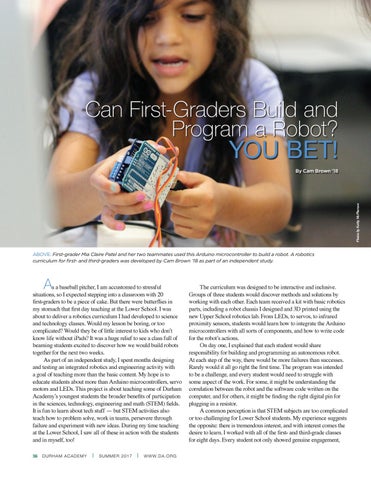Can First-Graders Build and Program a Robot?
YOU BET!
Photos by Kathy McPherson
By Cam Brown ’18
ABOVE: First-grader Mia Claire Patel and her two teammates used this Arduino microcontroller to build a robot. A robotics curriculum for first- and third-graders was developed by Cam Brown ’18 as part of an independent study.
A
s a baseball pitcher, I am accustomed to stressful situations, so I expected stepping into a classroom with 20 first-graders to be a piece of cake. But there were butterflies in my stomach that first day teaching at the Lower School. I was about to deliver a robotics curriculum I had developed to science and technology classes. Would my lesson be boring, or too complicated? Would they be of little interest to kids who don’t know life without iPads? It was a huge relief to see a class full of beaming students excited to discover how we would build robots together for the next two weeks. As part of an independent study, I spent months designing and testing an integrated robotics and engineering activity with a goal of teaching more than the basic content. My hope is to educate students about more than Arduino microcontrollers, servo motors and LEDs. This project is about teaching some of Durham Academy’s youngest students the broader benefits of participation in the sciences, technology, engineering and math (STEM) fields. It is fun to learn about tech stuff — but STEM activities also teach how to problem solve, work in teams, persevere through failure and experiment with new ideas. During my time teaching at the Lower School, I saw all of these in action with the students and in myself, too! 36
DURHAM ACADEMY
|
S U M M ER 2 0 1 7
|
W W W.DA.ORG
The curriculum was designed to be interactive and inclusive. Groups of three students would discover methods and solutions by working with each other. Each team received a kit with basic robotics parts, including a robot chassis I designed and 3D printed using the new Upper School robotics lab. From LEDs, to servos, to infrared proximity sensors, students would learn how to integrate the Arduino microcontrollers with all sorts of components, and how to write code for the robot’s actions. On day one, I explained that each student would share responsibility for building and programming an autonomous robot. At each step of the way, there would be more failures than successes. Rarely would it all go right the first time. The program was intended to be a challenge, and every student would need to struggle with some aspect of the work. For some, it might be understanding the correlation between the robot and the software code written on the computer, and for others, it might be finding the right digital pin for plugging in a resistor. A common perception is that STEM subjects are too complicated or too challenging for Lower School students. My experience suggests the opposite: there is tremendous interest, and with interest comes the desire to learn. I worked with all of the first- and third-grade classes for eight days. Every student not only showed genuine engagement,
